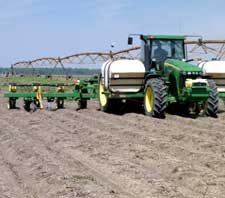
Plant Diseases
Cotton diseases have been contained largely through the use of resistant cotton varieties. Rotation to non-host crops such as grain or corn also breaks the disease cycle. Nematodes, while not truly a disease, cause the plant to exhibit disease-like symptoms. Nematodes are microscopic worm-like organisms that attack cotton’s roots causing the plant to stop growing, and as a result, causes reduced yield. Crop rotation is the primary method of managing for nematodes.
Soil Conservation
Cotton producers expend extra efforts to minimize soil erosion. Cotton is sensitive to wind-blown soil because the plant’s growing point is perched on a delicate stem, both of which are
 easily damaged by abrasion from wind-blown soil. For that reason, many farmers use minimum tillage practices which leave plant residue on the soil surface thereby preventing wind and water erosion.
easily damaged by abrasion from wind-blown soil. For that reason, many farmers use minimum tillage practices which leave plant residue on the soil surface thereby preventing wind and water erosion.
Conservation tillage, the practice of covering the soil in crop residue year ‘round, is common in windy areas. A growing number of producers also are moving to minimum tillage, or a no-till system, to reduce soil movement. In the rain belt, land terracing and contour tillage are standard practices on sloping land to prevent the washing away of valuable topsoil.
Irrigation
The cotton plant’s root system is very efficient at seeking moisture and nutrients from the soil. From an economic standpoint, cotton’s water use efficiency allows cotton to generate more revenue per gallon of water than any other major field crop.
 Most of the U.S. cotton acreage is grown only on rain moisture. A trend toward supplemental irrigation to carry a field through drought has increased in acreage and helped stabilize yields. Cotton’s peak need for water occurs during July, when it is most vulnerable to water stress. A limited supply of irrigation water is being stretched over many acres via the use of highly efficient irrigation methods such as low energy precision applications, sprinklers, surge and drip irrigation. Not only has irrigation stabilized yields for many growers, it also has allowed production in the desert states of California, Arizona and New Mexico.
Most of the U.S. cotton acreage is grown only on rain moisture. A trend toward supplemental irrigation to carry a field through drought has increased in acreage and helped stabilize yields. Cotton’s peak need for water occurs during July, when it is most vulnerable to water stress. A limited supply of irrigation water is being stretched over many acres via the use of highly efficient irrigation methods such as low energy precision applications, sprinklers, surge and drip irrigation. Not only has irrigation stabilized yields for many growers, it also has allowed production in the desert states of California, Arizona and New Mexico.

